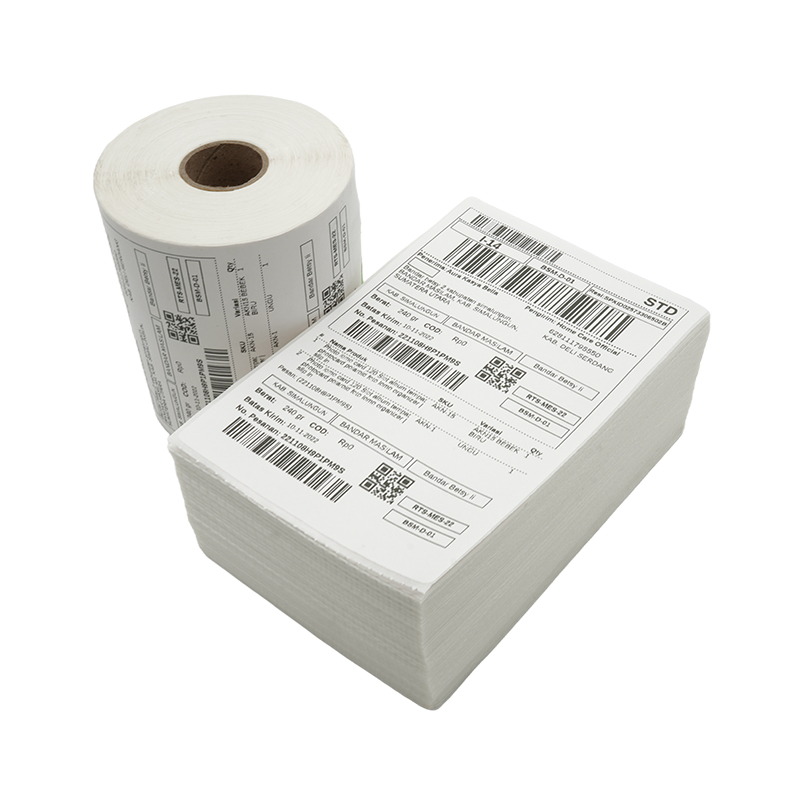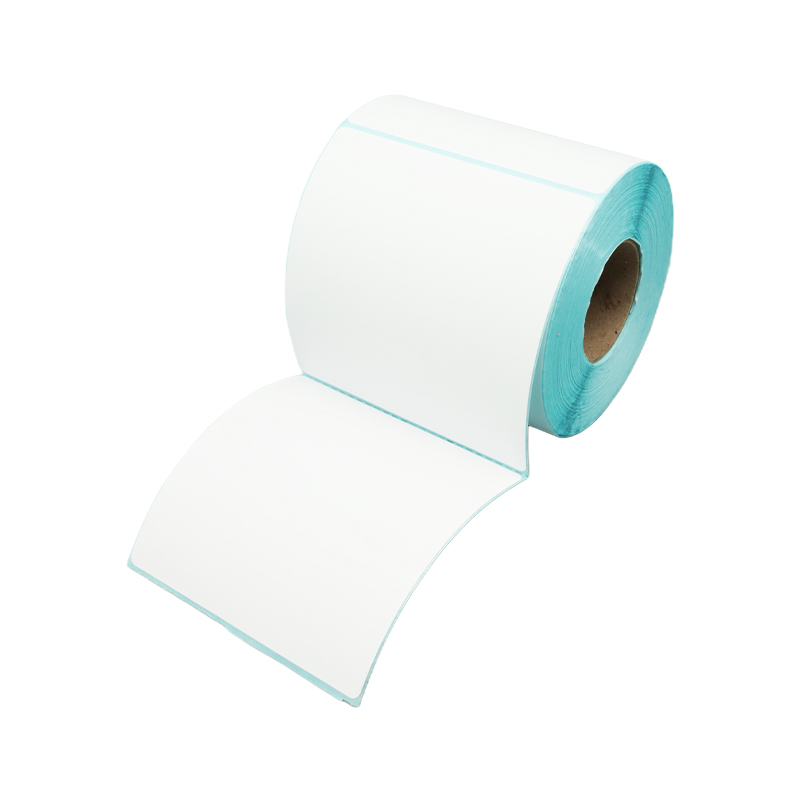How does three-proof thermal label paper achieve high-speed output without jams when printing on a thermal printer?
Release Time : 2025-09-18
With increasing demand for label durability, thermal label paper with waterproof, oil-proof, and scratch-resistant ("three-proof") properties has become widely used. However, many users are concerned that the specially coated three-proof thermal label paper, due to increased thickness and changes in the surface friction coefficient, may cause paper jams, paper feed problems, or print deviation during high-speed printing. In fact, high-quality three-proof thermal label paper, through the coordinated innovation of material optimization, coating process, and structural design, not only does not affect smooth printing, but also achieves more stable and efficient high-speed output.
1. Substrate Flatness and Stiffness Control: Ensuring Stable Paper Feed
Paper jams often arise from label paper bending, slipping, or skewing during paper feeding. Three-proof thermal label paper uses a high-stiffness, low-deformation base paper or synthetic paper to ensure that the paper remains flat during winding and unwinding. Furthermore, through precise coating and drying processes, curling caused by uneven coating is avoided. Good stiffness allows the label to maintain linear motion as it enters the printer's rollers, reducing frictional resistance against the paper guide, thereby improving paper feed stability and adapting to print speeds of 150-300 mm/s or even higher.
2. Surface Coating Optimization: Balancing Slip and Friction
The water-, oil-, and scratch-resistant properties of three-proof thermal label paper rely on a functional surface coating. However, an overly smooth or rough coating can compromise printing performance. To address this, manufacturers incorporate trace amounts of lubricants or micron-sized silica particles into the coating formula to create a "micro-rough" surface structure. This structure ensures effective contact between the label and the printhead, ensuring a sufficient thermal reaction, while also providing an appropriate coefficient of friction, ensuring smooth movement of the label under roller traction and avoiding slipping or jumping. Furthermore, the coating's strong adhesion to the substrate prevents detachment even under high-speed friction, preventing powder accumulation on the printhead or rollers and causing clogging.
3. Back Coating Technology: Reducing Friction and Protecting the Printhead
In addition to the surface coating, three-proof thermal label paper typically features a specialized back coating on the reverse side. This coating provides lubrication and antistatic properties, significantly reducing friction between the label and the printer rollers, ensuring smoother paper flow through the print path. Especially during high-speed continuous printing, the back coating effectively prevents paper sticking or stretching caused by frictional heat. Furthermore, the antistatic design prevents labels from attracting dust or sticking to each other in dry environments, further reducing the risk of paper jams.
4. Slitting Precision and Winding Quality: Ensuring Physical Consistency
High-quality three-proof thermal label paper is manufactured using precision laser or razor cutters to ensure smooth, burr-free, and dust-free edges. A high-precision tension control system is used during winding to ensure even and consistent tension on the ends of the label roll. Rough edges or uneven winding can easily cause labels to scrape against the printer guides or cause misalignment during high-speed paper feeding, leading to paper jams. Precision-slit and neatly wound label rolls work seamlessly with the printer's automatic paper feed mechanism, providing a seamless "plug-and-play" experience.
5. Synergistic Adaptation with Thermal Printing Mechanisms
Modern thermal printers generally feature automatic detection of paper width, thickness, and sensitivity. Three-proof thermal label paper is manufactured to strict thickness tolerances to ensure compatibility with printer settings. Furthermore, the thermal coating on this paper is optimized for fast response, ensuring clear color reproduction even at high print speeds, eliminating the need to reduce print speeds to ensure readability. This collaborative "material-device" design ensures stable output of three-proof thermal label paper even at high speeds, eliminating performance limitations and paper jams.
The high-speed, jam-free output of three-proof thermal label paper in thermal printers is the result of a synergistic combination of substrate control, coating technology, back-coating, precision machining, and equipment adaptation. It defies the conventional wisdom that durability and smooth printing are mutually exclusive, providing users with a labeling solution that is both durable and efficient.
1. Substrate Flatness and Stiffness Control: Ensuring Stable Paper Feed
Paper jams often arise from label paper bending, slipping, or skewing during paper feeding. Three-proof thermal label paper uses a high-stiffness, low-deformation base paper or synthetic paper to ensure that the paper remains flat during winding and unwinding. Furthermore, through precise coating and drying processes, curling caused by uneven coating is avoided. Good stiffness allows the label to maintain linear motion as it enters the printer's rollers, reducing frictional resistance against the paper guide, thereby improving paper feed stability and adapting to print speeds of 150-300 mm/s or even higher.
2. Surface Coating Optimization: Balancing Slip and Friction
The water-, oil-, and scratch-resistant properties of three-proof thermal label paper rely on a functional surface coating. However, an overly smooth or rough coating can compromise printing performance. To address this, manufacturers incorporate trace amounts of lubricants or micron-sized silica particles into the coating formula to create a "micro-rough" surface structure. This structure ensures effective contact between the label and the printhead, ensuring a sufficient thermal reaction, while also providing an appropriate coefficient of friction, ensuring smooth movement of the label under roller traction and avoiding slipping or jumping. Furthermore, the coating's strong adhesion to the substrate prevents detachment even under high-speed friction, preventing powder accumulation on the printhead or rollers and causing clogging.
3. Back Coating Technology: Reducing Friction and Protecting the Printhead
In addition to the surface coating, three-proof thermal label paper typically features a specialized back coating on the reverse side. This coating provides lubrication and antistatic properties, significantly reducing friction between the label and the printer rollers, ensuring smoother paper flow through the print path. Especially during high-speed continuous printing, the back coating effectively prevents paper sticking or stretching caused by frictional heat. Furthermore, the antistatic design prevents labels from attracting dust or sticking to each other in dry environments, further reducing the risk of paper jams.
4. Slitting Precision and Winding Quality: Ensuring Physical Consistency
High-quality three-proof thermal label paper is manufactured using precision laser or razor cutters to ensure smooth, burr-free, and dust-free edges. A high-precision tension control system is used during winding to ensure even and consistent tension on the ends of the label roll. Rough edges or uneven winding can easily cause labels to scrape against the printer guides or cause misalignment during high-speed paper feeding, leading to paper jams. Precision-slit and neatly wound label rolls work seamlessly with the printer's automatic paper feed mechanism, providing a seamless "plug-and-play" experience.
5. Synergistic Adaptation with Thermal Printing Mechanisms
Modern thermal printers generally feature automatic detection of paper width, thickness, and sensitivity. Three-proof thermal label paper is manufactured to strict thickness tolerances to ensure compatibility with printer settings. Furthermore, the thermal coating on this paper is optimized for fast response, ensuring clear color reproduction even at high print speeds, eliminating the need to reduce print speeds to ensure readability. This collaborative "material-device" design ensures stable output of three-proof thermal label paper even at high speeds, eliminating performance limitations and paper jams.
The high-speed, jam-free output of three-proof thermal label paper in thermal printers is the result of a synergistic combination of substrate control, coating technology, back-coating, precision machining, and equipment adaptation. It defies the conventional wisdom that durability and smooth printing are mutually exclusive, providing users with a labeling solution that is both durable and efficient.







